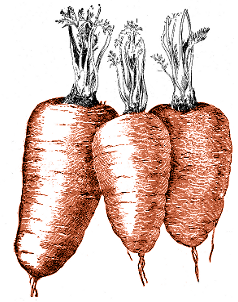Archive for the ‘Retrospective’ category
Posted in Garden Diary, Planning, Retrospective, The Old Garden In Bristol on Saturday, September 7th 2013 (10.29 PM).
Regular readers of this site – all one of you – might have noticed that things have been rather quiet for a while here. There is, of course, a good reason for that. The reason is: the state of the garden, in the second half of last year, was such a disaster that I really didn’t feel like writing about it. I really didn’t feel like going into the garden. And so, nothing was put away for the winter, everything was left to fend for itself. A surprising amount of plants survived the winter, but the ones that did were mostly killed off by the heat earlier this summer. So now, effectively, we are starting again. The only produce we’ve had from the garden in 2013 is a small bowl from an interloper, something very tasty that we didn’t really ask for.
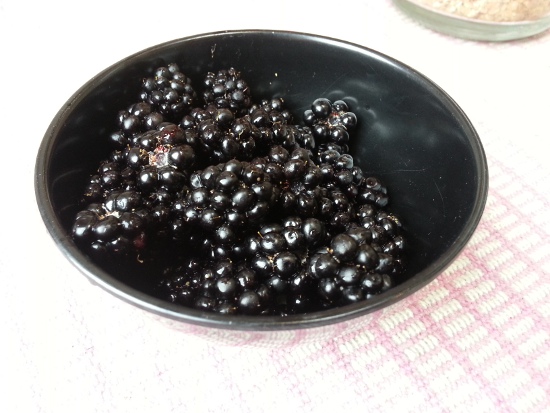
For some reason, gardening tasks always seem to end up involving brambles. I can dimly remember, aged about 5, my grandfather giving my parents a bramble shoot with the advice to keep it in a bucket lest it take over the whole garden. Naturally, by the time I had reached my teens, it had taken over, well, half the garden (the rest was lawn), and I spent what seems in memory to be most of a summer cutting it down, piece by piece, first with secateurs then with hacksaw, until my parents’ only option was to hire a wood chipper to deal with the pile of chunks. At the previous place we lived in Bristol, there was virtually no garden, and the only gardening task I ever did was regularly chop back a bramble which had managed to root itself under the decking. They really are amazing plants, in their ability to cover an area, take it over, turn everything underneath into a barren desert, and like bindweed they are endemic in this part of Bristol. So when I saw bramble runners sprouting forth over our back fence and dropping down seeking earth, I knew it had to go. After we’d eaten its fruit, of course.
The origin of the bramble is quickly explained, if we skip back to the garden plan posted a couple of years back:
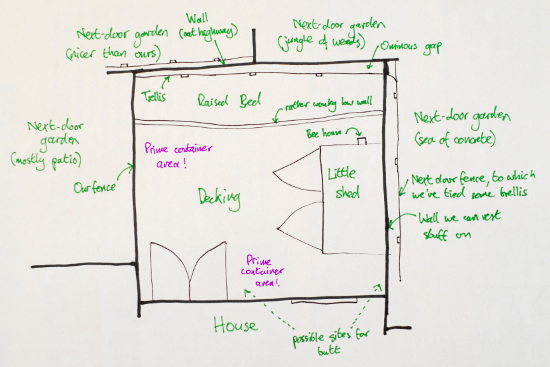
That area at top-right marked “Jungle of weeds” was all dug up about a year ago. They now have a shed, backing on to our boundary, and a high wooden fence extending off to the right. However, the cleared land on their side of said fence has been left to revert back to weediness. With their new fence, there is now double the Ominous Gap marked on the plan, and it’s this gap which has been colonised by bramble. I can reach down and chop off anything threatening to poke its way over into our space, but I have no hope at all of digging up the roots. In other words, my life is once again doomed to regularly cutting back brambles.
Apart from the bramble-hacking, what are we going to do now that we’ve admitted we’re going to restart from scratch? Try to plant things that don’t take as much nursing, for one thing, so that the garden will survive if we want a summer holiday; and things that don’t necessarily look appetising to every slug and snail in town. Lots of herbs, lots of insect-attracting flowers, and maybe the odd item of produce that we can’t easily buy here. For now, we’ve cut down the weeds that were colonising the back bed and sowed white clover for the winter, to refresh its nitrates and try to give the weeds no space to come back. Before the winter, we’ll start growing a bulb’s worth of garlic, and sow our spring flowers: of all last year’s produce, the garlic was the best harvest, and was barely touched by pests. Then, next year, hopefully things will be green again.
blackberry, bramble, clover, garlic, weeds, white clover
Posted in Garden Diary, Retrospective, The Old Garden In Bristol on Saturday, July 7th 2012 (2.50 PM).
A week ago, we passed the midpoint of the calendar year; a week or two before that, the midpoint of the solar year. A good place, I thought, to put together a little bit of a summary on how things are growing so far. With the weather, of course, it’s not going too well. There are bright spots, though. Here’s a summary, at least of the plants that are worth talking about.
- Potatoes: they’re not quite ready yet. Of the two batches of potatoes I planted, the first seem to be doing quite well. The second, though, are having problems. When I planted them, they were already far too leggy, and they stayed far too leggy as they grew. Because of that, they haven’t coped with the weather at all: they have flopped all over the place. For some reason, floppy potato plants are far more attractive to slugs and snails than tidy, well-behaved ones are.
- Green beans: the first batch were planted far too early, but happily sat in their pot for a month or two until the weather was warm enough. They’ve just reached the top of their poles, buds are starting to come, and the second batch I germinated are now ready to pot on.
- Runner beans: these went in a bit later than the green beans, and are already in full flower. They seem to be a little reluctant to set fruit, though; only one or two tiny embryo beans have been spotted so far. The standard advice for persuading beans to set seems to be “spray the flowers with water”, but given the weather I don’t really think that would help. Most of the salad leaves I planted around the base of the beans completely bolted before the weather turned wet, but some of the lettuce has been harvested and eaten.
- Garlic: also looking a bit windblown, and also not quite ready yet. They have, in the past couple of days, very quickly put forth a scape on each plant: the scapes are now safely in the fridge for eating.
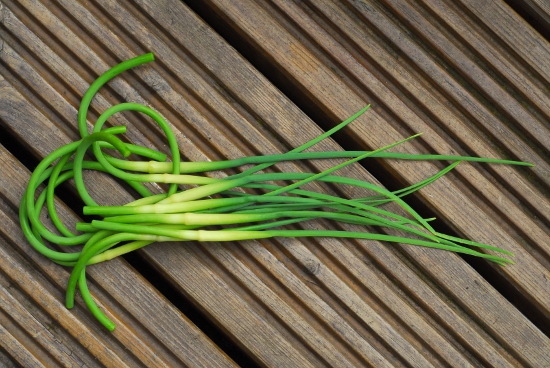
- Peas: if you ever hear anyone say to you “semi-leafless peas are self-supporting when sown in a block”, put your hands over your ears. And tape their mouth shut. And shoot them. This may be true in theory, but in reality I found that the growing peas could not cope at all with the weight of their pods. The first batch has already been harvested; and when I took them down, I could see just how twisted and serpentine the later batches have become. A final extra-big batch has been sown and planted on, spaced slightly further apart and with a lot more support provided by horizontal strings: I suspect the tight planting of the first couple of batches was the cause of the large number of pods with just two or three peas inside.
- Courgettes: the first of these were planted on about a month ago now, and seem to be doing fairly well. The first few flowers have bloomed: the problem is that with only a handful of plants, and the flowers only lasting a few days, it is difficult to get male and female flowers in bloom at the same time.
- Lemon balm: I picked these seeds up at the Bristol Seed Swap at the Cube Cinema back in February. Back in May, I put them in a pot, and waited for them to grow. Nothing happened, and I assumed something had gone wrong: all died, all rotted, all eaten by evil weevils. However, just this morning, I spotted one tiny seedling starting to emerge. Maybe it will turn out to be a lemon balm plant. So there’s a bright spot.
Writing out a list like this makes me aware of just how many different plants there are in the garden at the moment: I haven’t even had space to mention the mint; the basil mint; the peppermint; camomile; chervil; borage; French marigolds; English marigolds; cornflowers; thyme; lemon thyme; sage; rosemary; lavender; sweet peas; flat parsley; curly parsley; the fennel; or the chard. Probably best not to mention the chard at all, in fact, because I’m sure it’s a bad sign when your chard and your beans are the same height. Time to plant some more there, I think.
bean, chard, courgette, garlic, green bean, lemon balm, pea, potato, runner bean, summary, swiss chard
Posted in Experimentation, Garden Diary, Retrospective, The Old Garden In Bristol on Saturday, March 17th 2012 (3.59 PM).
A bit nippy out in the garden today: most certainly not as springlike as other days, with dark clouds massing overhead. Not at all like the warm, insect-filled garden of last weekend. Still, I did the things I meant to do: replanted the pea seedlings in their final location, sowed more peas to germinate on the windowsill, scattered a few “surprise” annual flower seeds in spare corners, and retreated to the sofa before the rain broke.
The pea seedlings have, like last year, gone in a box to stand on the garden wall. I should have transplanted them earlier: they were getting rather stuck in their tiny modules. The next batch of peas will start their hardening-up rather earlier, so they can be transplanted outside rather earlier too. The fennel I repotted last week is looking nicely at home, plenty of feathery new growth coming from the heart of both plants. The sweet peas are not so happy, still looking rather listless and floppy, so I have given them a bit more scaffolding to climb up: horizontal strings wrapped around their cane pyramid.
I said last time that I would explain a bit more about the fennel, and why we decided to get some. It is, essentially, to make up for last year. We tried to grow dill last year, and it was a bit of a failure.
If you look at a packet of dill seeds, you see a rather idealised picture: a big pot with a big dill plant inside it, leaves pouring down like a waterfall. Of course, if you’re growing dill for food, that’s what you need, because you need a good bunch of the individual fronds to put in your gravadlax. However, trying to grow dill from seed, that wasn’t what we got at all. The first plants we sowed in modules and tried to pot on: that failed entirely. The second plants we sowed in their final location; they put out a few leaves, then immediately bolted to a few feet high and flowered. Hardly any leaves at all, not even enough to make a single meal out of. The flower heads are pretty: finely-divided cadmium-yellow umbels; but, to be honest, I like eating dill too much to be satisfied with that. Why did it happen? I suspect the pot we put them in was rather too shallow, and the plants’ roots felt rather too cramped for comfort.
Now, in all the books I’ve read, it says: “don’t grow dill and fennel together”. They might give a reason, too, but if they have I haven’t absorbed it, come away only with the idea that they don’t work well together for some reason. I picture the real explanation being like primary school parents’ evening: “honestly, we love little Fennel, and he’s fine on his own, but when him and Dill get together they do tend to egg each other on. Mrs Anderson still can’t bear the sight of pencil shavings, and it was four months ago now…” Anyway, whatever the reason is, as we were trying to grow dill last year, we thought that fennel must be avoided at all costs. As I’m now completely exasperated with trying to get dill to grow, this year it is the fennel’s turn. We don’t have room for more than a couple of bulbs, so we won’t get more than a single side dish from it at the end of the season – fennel gratin is delicious, by the way. I’m more interested to see if its leaves can be used like dill, or if they will end up as purely structural plants for the summer – hopefully they will give the garden a more delicate sense of height than things-up-canes can provide.
dill, fennel, pea, sweet pea
Posted in Retrospective, The Old Garden In Bristol on Sunday, October 16th 2011 (9.05 AM).
This post is, unfortunately, going to be rather low on photos compared to those previous, because plants that aren’t growing well, are dying off or somehow going wrong, aren’t really inviting subjects for the camera. I’ve resisted the temptation, though, to title it “Failures”, because all of these plants gave something to the garden, even if it was just a clump of foliage or something for the local caterpillars to eat.
Pattypan squash: this is an example of why you should be careful what plants you let into your garden. We decided we wanted a pattypan squash plant: they can look rather attractive, and we always use plenty of squash in cooking. By the time we decided we wanted one, though, it was definitely a bit late in the season to be growing one from seed. We went down to one of the local garden centres; all the pattypans they had looked to have signs of mildew on their leaves. We bought the best we could find, but the signs of mildew did indeed turn into worse mildew. It fruited, but its fruits were hardly an inch across. Of course, I’ve heard since, this year has been a bad year for squashes, but I’m sure that a healthier plant would have had a better chance of success.
Dill: We love dill, particularly with salmon in the Scandinavian style, so dill had to be a must for the garden. We planted plenty of dill seeds, and they sprung right up, right away. But then they didn’t stop springing. Every dill plant we grew turned into a tall, spindly thing, four or five feet high but with barely any usable foliage. Pinching out the tips didn’t seem to help.
Spring onions: these we grew from seed, and they started out well. They seemed to be taking a while, but we weren’t too worried, having picked a variety with a low chance of bolting. Then, though, a period of hot weather followed by heavy rain ruined the majority of the plants, snapping the stems. A handful have grown back from that, but neither those nor the ones which avoided the rain in the first place have really reached a harvestable thickness.
Sweet peas: the idea with these was: companion plants around our green beans. The problem with them was: they grew too well. They grew around the beans, over them, taller than them, almost swallowing them up. And then didn’t even flower. The problem, maybe, is that sweet peas aren’t bred to grow in vegetable-quality compost, which is possibly an issue with any companion planting scheme that involves decorative and produce plants mixed in together.
Japanese saltwort: we spotted this in one of the local garden centres, the excellent Riverside co-operative. We bought it because it was intriguing, and unusual. It grew, grew well. The problem, though was that we didn’t really know what to do with it; and its heart quickly became dead and woody, the living parts straggling over the edge of its pot. I have the feeling it is one of those plants which, if not kept in a container, could easily take over an entire garden.
What to learn from all this? Well, next year, we’ll definitely be keeping our spring onions rather more sheltered. We’re on the hunt, too, for a different variety of dill to try. The most important thing to remember, though: however much we want a particular variety of plant in the garden, only let it come in if it’s healthy.
dill, japanese saltwort, pattypan squash, saltwort, scallion, spring onion, squash, sweet pea
Posted in Retrospective, The Old Garden In Bristol on Saturday, October 1st 2011 (11.10 AM).
The list, in the previous post, of plants we’ve grown this year wasn’t really in any particular order; just off the top of my head as I cast my mind around the garden. Here, though, are some of the plants that we can say were a success.
Potatoes: probably our biggest success, grown in a dustbin with holes drilled in the bottom. We grew them in a mixture of soil and compost, at first, earthing up regularly with compost until it reached the top of the bin. I was expecting flowers and fruit, which we didn’t get; and we were rather worried about a leafhopper infestation which developed, damaging the leaves quite a bit. When the foliage died back, though, we upended the bin and found a healthy crop, about 600g per seed. Next year, we hope to have room for a couple more bins.
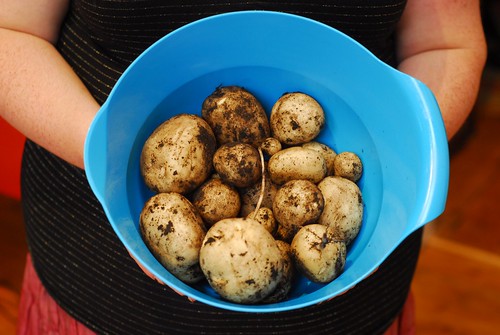
Peas: we bought small plants from the garden centre, planted them up in wine boxes, and put them on top of the garden wall, trained up the latticework. Again, each plant gave us a plentiful harvest; but we did have a bit of a mildew problem, probably caused by planting too many in each box.
French marigolds: we didn’t manage to eat any, but the plants themselves have gone happily on producing flowers all summer. They’re still in flower now, with more buds on the way.
Swiss chard: we planted this in a variety of containers, and tried harvesting and eating it at a variety of stages, from baby leaves to fully-grown leaves and stems. All of them worked pretty well: the baby leaves were ready fairly fast, and harvesting most of those left room for a few plants to grow into adulthood. Moreover, what we weren’t expecting was that we would be able to treat the adult plants in a cut-and-come-again fashion; we thought we’d harvested everything we could a few weeks back, but we now have healthy and harvestable leaves waiting for us again.
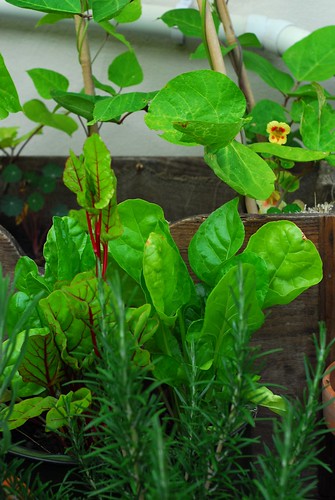
Mint: it grew, despite the best attempts of leaf-miners and caterpillars to eat it. Moreover, we kept forgetting we had mint leaves to use, leaving the mint bush to get rather overgrown and straggly; giving it a fierce trim rather more often would have left us with a healthier plant.
Feverfew: it grew very well, with attractive clusters of daisy-like flowers that have lasted well all summer. Now, we just have to work out what else it might be useful for.
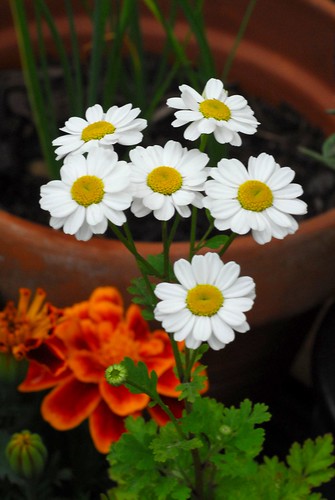
calendula, feverfew, french marigold, marigold, mint, pea, pentland early, potato, review, swiss chard
Posted in Retrospective, The Old Garden In Bristol on Tuesday, September 27th 2011 (6.29 PM).
Before we start to plan what will be going where next year, I thought it would be worthwhile putting together a brief list of what we’ve done this year, and how well it worked. And, when it’s all written down on a page, it does look like we’ve managed an awful lot. In 2011, we have grown:
- First early potatoes
- Peas
- English marigolds
- French marigolds
- Sweet peas
- Beetroot
- Spring onions
- Carrots
- Swiss chard
- Japanese saltwort
- Radishes
- Pattypan squash
- Wild Rocket
- Violas
- Marjoram
- Mint
- Basil mint
- Basil
- Runner beans
- Green beans
- Nasturtiums
- Thyme
- Feverfew
- Camomile
- Sage
- Curled parsley
- Flat parsley
- Chives
- Dill
- Coriander
- Salad leaves
- Lavender
Yes. A long list. Some of it worked, some didn’t, and an awful lot can be filed under “sort of worked, but we could have done better”. All of these things were planted in various sizes of container around the garden, nothing in the back bed at all, because we are still digging it up in an attempt to root out all the broken glass and make it safe to dib holes in with our fingers. I will, in the next few posts, break down the unmanageable list above into successes, disasters, and the catch-all “somewhere in between”.
list, review



